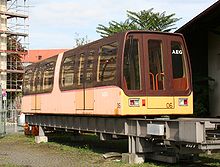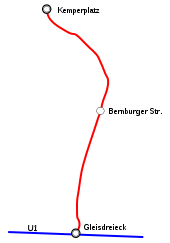- M-Bahn
-
Berlin M-Bahn
M-Bahn train 06 at the Nuremberg Transport MuseumOverview Type Maglev System AEG Rail Systems Status dismantled Locale Berlin, West Germany Termini Gleisdreieck
KemperplatzStations 3 Operation Opened 1989-08-28 (testing)
1991-07-18 (service)Closed 1991-07-31 (closed)
1991-09-17 (dismantled)Owner Magnetbahn GmbH Character Elevated metro Rolling stock 1× M70/2
6× M80/2
1× maintenance vehicleTechnical Line length 1.6 km (1.0 mi) No. of tracks Single/Double track Operating speed 80 km/h (50 mph) Route map M-Bahn 

Kemperplatz 







Bernburger Str 





old Line U2 



Gleisdreieck At time of operation
The M-Bahn or Magnetbahn was an elevated Maglev train line operating in Berlin, Germany in 1991. The line was 1.6 km in length, and featured three stations, two of which were newly constructed. The line was built to fill a gap in the public transport network created by the construction of the Berlin Wall, and was rendered redundant by the reunification of Berlin.
The M-Bahn was the second Maglev line to open to public traffic, after the Birmingham Maglev but before the Shanghai Maglev Train. Construction and running were undertaken by Magnetbahn GmbH.
Contents
History
The first section of the Berlin U-Bahn to be built included an elevated section between Gleisdreieck and Potsdamer Platz stations. After the partition of Berlin, Gleisdreieck station was in West Berlin whilst Potsdamer Platz station was just in East Berlin. After the building of the Berlin Wall in 1961, the stretch of line between the two stations, as well as the platforms used by the line at Gleisdreieck, were abandoned.[1]
The area of West Berlin adjacent to Potsdamer Platz then required a connection to the U-Bahn, and this need was eventually met by the construction of the M-Bahn, which used the abandoned U-Bahn platforms at Gleisdreieck and the U-Bahn tracks northwards towards the border. It then diverged slightly to the west to terminate close to Potsdamer Platz but still in West Berlin.[1]
Work on the line started in 1983, and the first test runs, without passengers, took place in June 1984 on the southern section of the line. Initial testing used a car previously used on Magnetbahn GmbH's test track near Braunschweig, and the first two cars specifically built for Berlin were delivered in late 1986. The original intention was for public service to start in May 1987, but a fire at Gleisdreieck station in April of that year destroyed one of the two cars and badly damaged the other.[1]
Eventually four more cars, of the same design as the original two, were built. Several planned opening dates were not met, and in December 1988, a test train failed to stop at Kemperplatz and one of the cars crashed to the ground and was destroyed. A public service eventually started in August 1989, although service was intermittent and not guaranteed, and fares were not charged. Official regular passenger service, as part of Berlin's integrated public transport system, started in July 1991.[1]
By this time the Berlin Wall had fallen, something that could not have been predicted when construction started. It became desirable to re-establish the U-Bahn line that had previously been severed, requiring the removal of the M-Bahn from its right of way. The principal need for the M-Bahn had also been removed, as the area served by it was again easily accessible from the Potsdamer Platz station.Dismantling of the M-Bahn started only two months after its official opening, and was completed during February 1992. The U-Bahn connection between Gleisdreieck and Potsdamer Platz stations was reinstated, becoming part of line U2.[1]
Route
The line ran approximately north-south from a station at Kemperplatz on the edge of the Tiergarten park, with three stations in total, the most southernly being on the lower level of the present-day Gleisdreieck U-Bahn interchange.
- Kemperplatz 52°30′40″N 13°22′18″E / 52.510980556°N 13.37176111°E (now the location of the Sony Center at Potsdamer Platz, close to the present Berlin Potsdamer Platz railway station)
- Bernburger Str. 52°30′20″N 13°22′33″E / 52.5056°N 13.37588611°E (close to the present site of Mendelssohn-Bartholdy-Park U-Bahn station)
- Gleisdreieck 52°29′59″N 13°22′27″E / 52.499775°N 13.37418333°E (now reclaimed for its original U-Bahn use)
The new section from Kemperplatz and through Bernburger Str. was double track with two parallel guideways, narrowing to single track between Bernburger and Gleisdreieck as it transferred onto the existing U-Bahn viaducts. The M-Bahn guideway used the western side of the viaducts approaching and into the single platform at Gleisdreieck, with standard gauge railway track remaining on the eastern side.
Both Kemperplatz and Bernburger Str. stations have since been demolished, along with structure carrying the M-Bahn between them.
Rolling stock
The M-Bahn operated a total of eight cars, although not all were used in public service.[1][2]
Car Type Builder In Service Notes 01 M80/2 Waggon Union March 1987 Destroyed in fire April 1987 02 M80/2 Waggon Union March 1987 Damaged in fire April 1987 and subsequently withdrawn 03 M80/2 Waggon Union May 1987 Destroyed in accident December 1988 04 M80/2 Waggon Union May 1987 Withdrawn September 1991 05 MBB April 1984 Diesel propelled works car, no magnetic drive, removed 1986 06 M80/2 Waggon Union August 1989 Withdrawn September 1991, preserved at the Nuremberg Transport Museum 07 M80/2 Waggon Union August 1989 Withdrawn September 1991 706 M70/2 MBB June 1984 Built in 1978 for the Braunschweig test track, used for initial testing in Berlin until October 1986 Technology
For propulsion, the M-Bahn used a long stator linear motor. However, unlike the Transrapid and other magnetic levitation trains, only 85% of the M-Bahn vehicle weight was supported by magnetic levitation, with the balance being supported by traditional wheels.
During operation, the Berlin M-Bahn line ran as an automated driverless operation, although the system had been designed to be driven by a human driver if required.
A cross-over existed just south of Kemperplatz, to allow use of double-track running. The M-Bahn train was supported across the points by a length of traditional rail below the guideway to support it across the gap.
References
- ^ a b c d e f Hardy, Brian (1996). The Berlin U-Bahn. Capital Transport Publishing. pp. 40–41. ISBN 1854141848.
- ^ "M-Bahn Berlin - Fahrzeuge [M-Bahn Berlin - Rolling Stock]" (in German). Berliner Verkehrsseiten. http://www.berliner-verkehrsseiten.de/m-bahn/Fahrzeuge/fahrzeuge.html. Retrieved 2010-06-26.
External links
Categories:- Rail transport in Berlin
- Rapid transit in Germany
- Maglev
Wikimedia Foundation. 2010.


